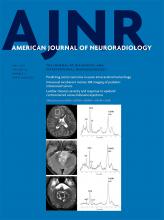Abstract
BACKGROUND AND PURPOSE: The flow-diverter device has been established as a treatment procedure for large unruptured intracranial aneurysms. The purpose of this study was to compare the usefulness of Silent MR angiography and time-of-flight MRA to assess the parent artery and the embolization state of the aneurysm after a flow-diverter placement.
MATERIALS AND METHODS: Seventy-eight large, unruptured internal carotid aneurysms in 78 patients were the subjects of this study. After 6 months of treatment, they underwent follow-up digital subtraction angiography, Silent MRA, and TOF-MRA, performed simultaneously. All images were independently reviewed by 2 neurosurgeons and 1 radiologist and rated on a 4-point scale from 1 (not visible) to 4 (excellent) to evaluate the parent artery. The aneurysmal embolization status was assessed with 2 ratings: complete or incomplete occlusion.
RESULTS: The mean scores of Silent MRA and TOF-MRA regarding the parent artery were 3.18 ± 0.72 and 2.31 ± 0.86, respectively, showing a significantly better score with Silent MRA (P < .01). In the assessment of the embolization of aneurysms on Silent MRA and TOF-MRA compared with DSA, the percentages of agreement were 91.0% and 80.8%, respectively.
CONCLUSIONS: Silent MRA is superior for visualizing blood flow images inside flow-diverter devices compared with TOF-MRA. Furthermore, Silent MRA enables the assessment of aneurysmal embolization status. Silent MRA is useful for assessing the status of large and giant unruptured internal carotid aneurysms after flow-diverter placement.
- © 2019 by American Journal of Neuroradiology












